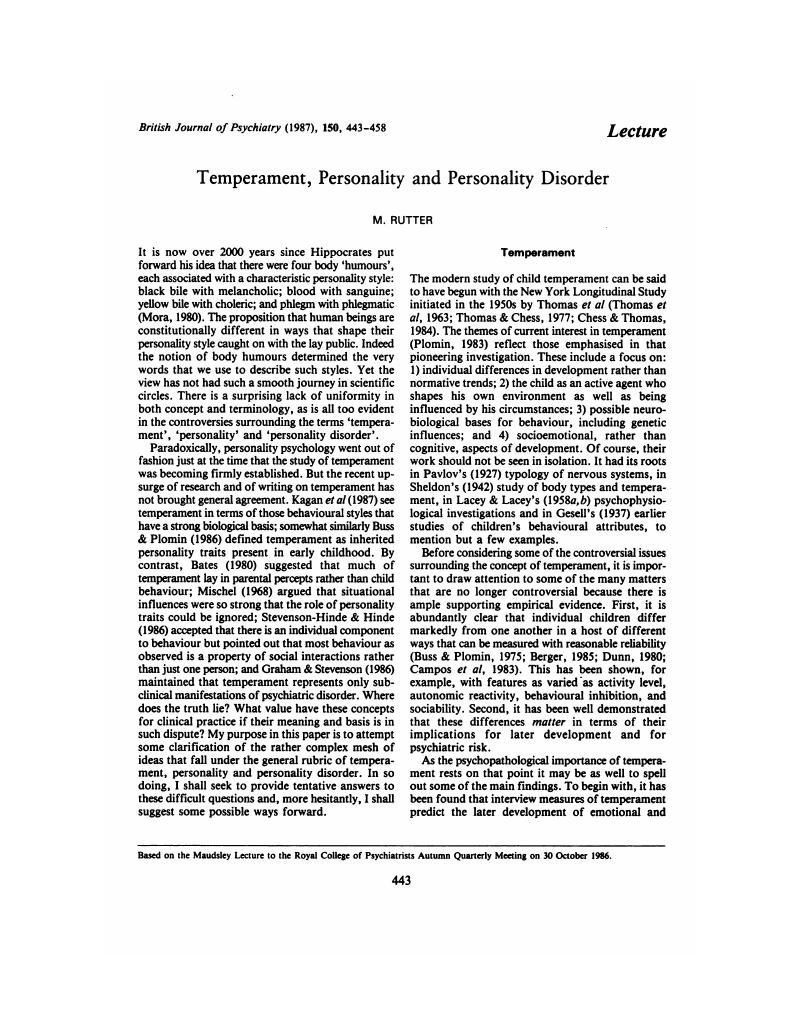Crossref Citations
This article has been cited by the following publications. This list is generated based on data provided by Crossref.
Rutter, Michael
1987.
[No Title].
British Journal of Psychiatry,
Vol. 150,
Issue. 6,
p.
873.
Cosyns, P.
1988.
Personality and Neurosurgery.
p.
121.
Baum, Cynthia G.
1989.
Handbook of Child Psychopathology.
p.
171.
Rutter, Michael
1989.
Child Psychiatric Disorders in ICD‐10.
Journal of Child Psychology and Psychiatry,
Vol. 30,
Issue. 4,
p.
499.
Standage, Kevin
1989.
Structured Interviews and the Diagnosis of Personality Disorders*.
The Canadian Journal of Psychiatry,
Vol. 34,
Issue. 9,
p.
906.
Lancaster, Sandra
Prior, Margot
and
Adler, Robert
1989.
Child Behavior Ratings: The Influence of Maternal Characteristics and Child Temperament.
Journal of Child Psychology and Psychiatry,
Vol. 30,
Issue. 1,
p.
137.
RUTTER, MICHAEL
1989.
Isle of Wight Revisited: Twenty-five Years of Child Psychiatric Epidemiology.
Journal of the American Academy of Child & Adolescent Psychiatry,
Vol. 28,
Issue. 5,
p.
633.
Rutter, Michael
1989.
Pathways from Childhood to Adult Life*.
Journal of Child Psychology and Psychiatry,
Vol. 30,
Issue. 1,
p.
23.
Hill, J.
Harrington, R.
Fudge, H.
Rutter, M.
and
Pickles, A.
1989.
Adult Personality Functioning Assessment (APFA).
British Journal of Psychiatry,
Vol. 155,
Issue. 1,
p.
24.
Rutter, Michael
1989.
Early Influences Shaping The Individual.
p.
229.
Kutcher, S.P.
Marton, P.
and
Korenblum, M.
1989.
Relationship between Psychiatric Illness and Conduct Disorder in Adolescents.
The Canadian Journal of Psychiatry,
Vol. 34,
Issue. 6,
p.
526.
Maziade, Michel
Thivierge, Jacques
Côté, Robert
Boutin, Pierrette
and
Bernier, Hugues
1989.
Significance of Extreme Temperament in Infancy for Clinical Status in Preschool Years.
British Journal of Psychiatry,
Vol. 154,
Issue. 4,
p.
544.
Adler, David A.
Drake, Robert E.
and
Teague, Gregory B.
1990.
Clinician's practices in personality assessment: Does gender influence the use of DSM-III axis II?.
Comprehensive Psychiatry,
Vol. 31,
Issue. 2,
p.
125.
MUFSON, LAURA
FENDRICH, MICHAEL
and
WARNER, VIRGINIA
1990.
The Stability of Temperament by Child and Mother Reports over Two Years.
Journal of the American Academy of Child & Adolescent Psychiatry,
Vol. 29,
Issue. 3,
p.
386.
Carr, Alan
1990.
A Formulation Model for Use in Family Therapy.
Australian and New Zealand Journal of Family Therapy,
Vol. 11,
Issue. 2,
p.
85.
Kennedy, Sidney H.
McVey, Gail
and
Katz, Randy
1990.
Personality disorders in anorexia nervosa and bulimia nervosa.
Journal of Psychiatric Research,
Vol. 24,
Issue. 3,
p.
259.
Tyrer, P.
Seivewright, N.
Ferguson, B.
Murphy, S.
Darling, C.
Brothwell, J.
Kingdon, D.
and
Johnson, A. L.
1990.
The Nottingham Study of Neurotic Disorder: relationship between personality status and symptoms.
Psychological Medicine,
Vol. 20,
Issue. 2,
p.
423.
Tyrer, Peter
Fowler-Dixon, Ruth
Ferguson, Brian
and
Kelemen, Andras
1990.
A plea for the diagnosis of hypochondriacal personality disorder.
Journal of Psychosomatic Research,
Vol. 34,
Issue. 6,
p.
637.
Dowson, J. H.
and
Berrios, G. E.
1991.
Factor structure of DSM‐III‐R personality disorders shown by self‐report questionnaire: implications for classifying and assessing personality disorders.
Acta Psychiatrica Scandinavica,
Vol. 84,
Issue. 6,
p.
555.
Wolff, Sula
1991.
‘Schizoid’ Personality in Childhood and Adult Life III: The Childhood Picture.
British Journal of Psychiatry,
Vol. 159,
Issue. 5,
p.
629.






eLetters
No eLetters have been published for this article.